by Heather Plett | Jan 17, 2015 | Labyrinth, Spirituality, Uncategorized
 “Release, receive, and return.” That’s what the labyrinth invites us to do.
“Release, receive, and return.” That’s what the labyrinth invites us to do.
Yesterday, I needed to release, receive, and return. I was stressing out about the ongoing tension between “do the thing that brings in money” and “do the thing that’s calling you next” – the ever-present question of all soulful entrepreneurs.
I wanted to go to the labyrinth, but it’s covered in snow, so I did the next best thing… I made a finger labyrinth. It turns out that making a labyrinth is almost as good as walking one for that whole “release, receive, and return thing.”
Since I use labyrinths a lot in my work (especially The Spiral Path, which is a 21 lesson journey through the labyrinth to your authentic heart), I thought I’d share the steps in making my finger labyrinth in case you’d like to make one too.
You’ll need:
- a square canvas or piece of wood (I used an 11X11″ canvas)
- a print out of your favourite labyrinth design, printed to the scale of the canvas (For an 11X11 canvas in the 7 path Chartres design that I made, here’s a pdf that prints on two 8.5X11 pieces of paper. If you prefer a different design, just Google “labyrinth template”)
- heavy string
- glue (I used a hot glue gun and white glue, but if you don’t have a glue gun, white glue is fine)
- newsprint or other paper (whatever you use should be fairly thin)
- mod podge (or just use gel medium)
- gel medium
- acrylic paint
Step 1. Print the labyrinth design and glue it onto the canvas or board. I used ordinary white glue, spread thin with a spreader (any straight plastic edge, like an old credit card) will work. Use the spreader to work out any bubbles in the paper (though it doesn’t have to be too fussy, since you’ll cover it).
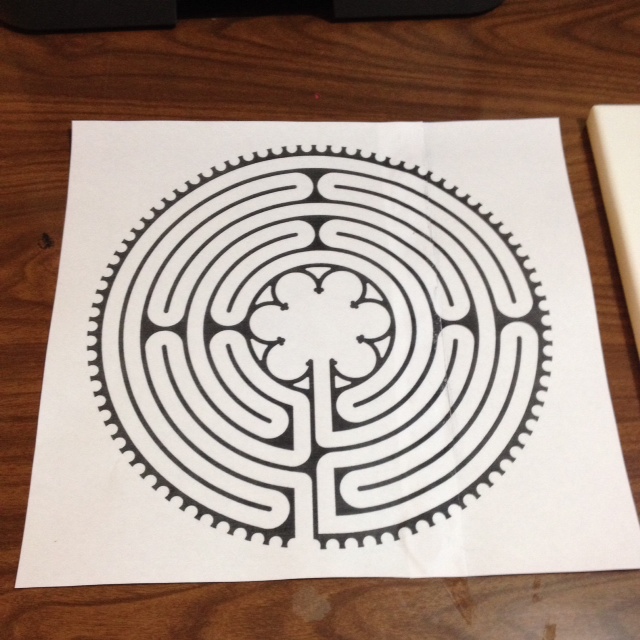
Step #2. Glue heavy string onto all of the black lines. I used the hot glue gun for this because it dries faster, but it would work fine with white glue.
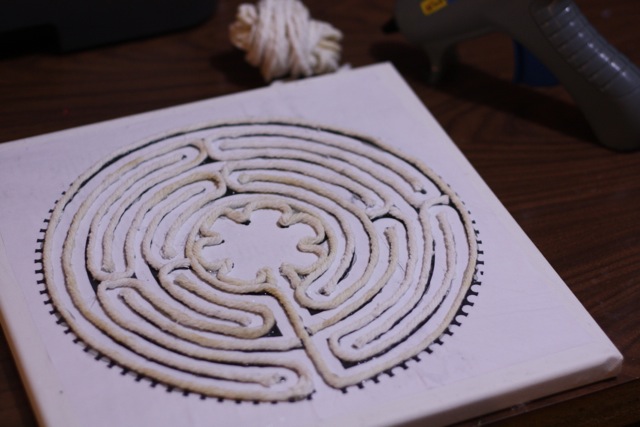
Step #3. Cut lots of short strips of newsprint. I used blank newsprint, because it’s easier to paint over, but you could use newspaper. You could also use coloured paper if you don’t want to paint it. Tissue paper would also work, but you’d need a few layers to make sure the black is covered. The strips I used were approx. .75″ by 3″. You don’t have to be fussy about it, but you’ll want them wide enough to cover the string and adhere to the surface without covering two lines of string at the same time.
Step #4. Slather mod podge (or gel medium) generously on a section of string. Add a strip of paper and cover the paper with more mod podge (or gel medium). The best way to do this is with your fingers, so be prepared to get a little messy.
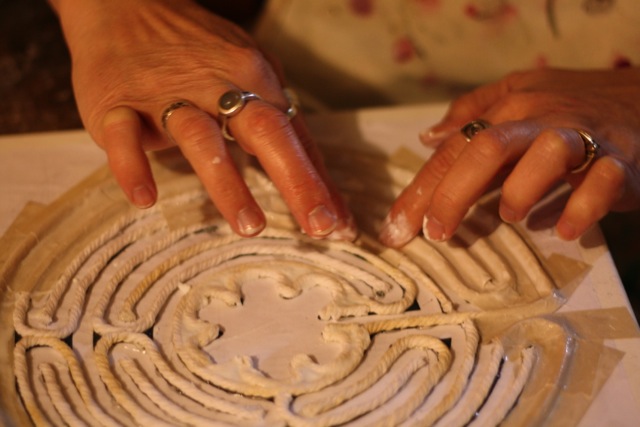
Step #5. Keep going until you have the whole labyrinth and canvas covered with strips of paper. Some spots are tricky (especially if you decide to do the flower pattern at the centre, like I did), so you’ll have to let go of your inner perfectionist and let it be a little imperfect. Make sure it’s all well coated with mod podge (or gel medium). Let it dry.

Step #6. If you want to paint it, add a layer of gel medium once it’s dry (this time you can do it with a paint brush) to smooth out some of the rough edges and to make sure the paint adheres to the surface.
Step #7. Paint it however you like. I used three tones of acrylic paint for the ombre effect (crimson, burnt sienna and ochre.
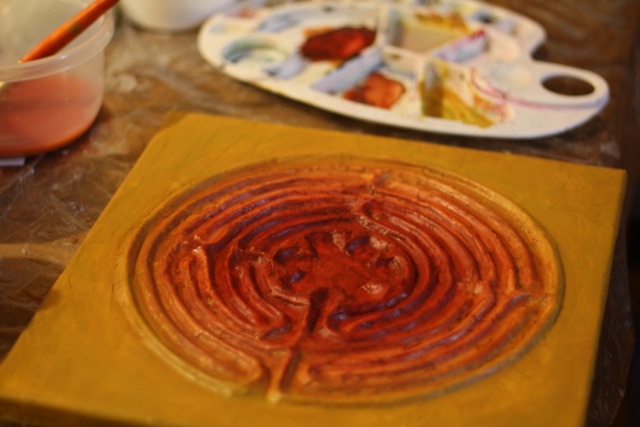
Step #8. If you want to give it a more textured, aged effect, rub a glaze over it. I used a brown glaze (acrylic paint mixed with gel medium) and rubbed it on with your fingers. Because I’d layered on the gel medium a little too thick, there were some cracks and the dark glazed picked these up, giving it a bit more of an aged look.
Step #9. Hang it on your wall or keep it in your studio, bedroom, or sanctuary where you can use it as a meditation tool.
Here are some tips for using your finger labyrinth…
- Before you start, take some time to settle in to a position in which you’re comfortable. Take some slow deep breaths to centre you in your practice.
- You may want to journal before and/or after the practice.
- Before you begin, you may wish to set an intention or ask a question that you will carry with you into the labyrinth, but be careful to keep it open-ended so that you’re open to surprise.
- Say a prayer, if you like, for support, healing, and guidance.
- Place a finger at the entrance of the labyrinth. Some people suggest that you use your non-dominant hand, as research suggests that our non-dominant hand has easier access to our intuition.
- As you follow the path with your finger inward, be conscious and intentional about releasing whatever stresses, worries, or distractions you might be feeling. Breathe deeply and slowly.
- Pause whenever you want, but don’t lift your finger off the labyrinth.
- When distracting thoughts come up, simply let them pass and wish them well as they leave your mind.
- When you reach the centre, pause for awhile and receive. Be open to whatever guidance and wisdom you may need, even if it’s not what you expected.
- When you’re ready, follow the path outward, consciously returning and bringing the wisdom of the centre out into your life with you.
- In your journal, write or sketch anything that came to you while you made the journey.
- Don’t try too hard. Sometimes the wisdom of the labyrinth is simply the pause that it forces you to take. Sometimes nothing obvious shows up, but that doesn’t mean it wasn’t time well spent. Stay open and receptive.
Starting February 1, 2015, you can join me in a 21 lesson journey through the labyrinth, back to your authentic heart in The Spiral Path: A Woman’s Journey to Herself. In the first seven lessons, you’ll release what no longer serves you. In the next seven lessons, you’ll open yourself to receiving. In the final seven lessons, you’ll return from the journey.
by Heather Plett | Jan 15, 2015 | calling, change, Let go of the ground, Uncategorized
“Something is shifting in my life. I feel lost. Everything I once depended on and believed in feels unstable and unreliable. I don’t know who I am anymore.”
I hear some version of this story almost every week in my coaching work. Somewhere in the middle of their lives, women (and men, though I hear fewer of those stories) go through a period of transition when their world shifts and the ground feels wobbly under their feet. They’ve left behind an old story but haven’t found themselves in the new story yet. They don’t know how to define themselves anymore and they’re not even sure they have much value.
The stories are almost always accompanied with tears and some measure of shame. They think they’re doing it wrong. They think everyone else has it figured out. They think there’s supposed to be a straight path between the old story and the new story. Or they think they were foolish and selfish for no longer being satisfied with the old story that once felt comfortable.
They’ve been fed a false narrative.
While still in high school, they were told that they’re supposed to figure out “what they want to be when they’re older” and then they’re supposed to follow a straight path to the “American dream.” They’re pretty sure that means that once they’re forty, they should have everything figured out and the question that once plagued them will have all been answered or at least have faded in importance.
But once they get to a midlife point, they realize that the questions are getting bigger and more urgent. They don’t know what to believe anymore. They don’t really know who they are. They don’t understand the meaning of their lives. They discover that motherhood, or their career, or the book they got published, or the dream they brought to fruition doesn’t satisfy them as much as they’d hoped. They’re feeling empty and lost, like a boat adrift at sea.
It’s such a common story that if I had a dollar for every time I’ve heard it, I could go on a very lovely vacation to the Caribbean.
The first thing I do when I hear this story is give them permission to cry and feel the grief. The second thing I do is tell them “This is where you’re supposed to be. This is a woman’s journey. You have to give yourself permission to be lost for awhile. It’s the only way you’ll find the path to your more authentic self.”
We all need to go through the empty place in order to connect with our deeper selves.
Every woman I know who has found her way into a deepened wisdom and a deeper sense of calling has gone through the empty place between stories. They’ve all found themselves adrift at sea somewhere in the middle of their lives, where they had to let go of old paradigms, old belief systems, and old ways of defining themselves. It was only when they let go of the resistance and the need to “be productive” and “be successful” that they were able to sink into the deep stillness of the empty place between stories.
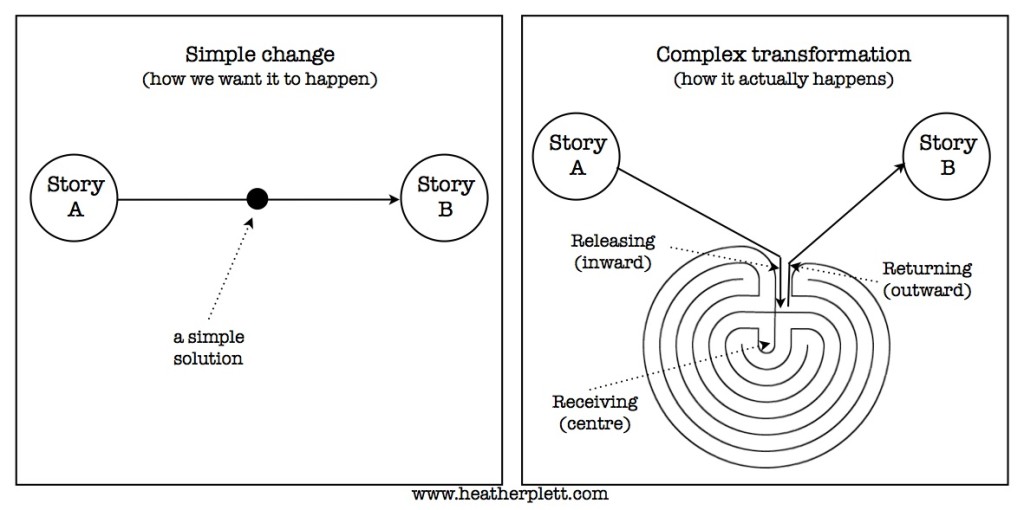
Nobody wants the complexity of real transformation.
The mess and the grief of letting go of the old story is scary and uncomfortable. We want the simple solution that many of the self-help books are selling us. We want ten easy bullet points.
But real transformation is more like the labyrinth. Real transformation invites us to step off the path into a complex, labyrinthine journey.
“Most of us arrive at a sense of self and vocation only after a long journey through alien lands. But this journey bears no resemblance to the trouble-free “travel packages” sold by the tourism industry. It is more akin to the ancient tradition of pilgrimage – ‘a transformative journey to a sacred centre’ full of hardships, darkness, and peril.” – Parker Palmer, Let your Life Speak
The labyrinth teaches us much about the journey through transition.
When we enter the labyrinth, we are invited to release. We let go of Story A. We let go of our expectations, our “American dream”, our comfort level.
Once we reach the centre, we are ready to receive. But our cups can only be filled up again if we reach that place empty and open. We’ve emptied ourselves of the old story so that the new story can begin to grow. At the centre, we receive guidance from Spirit, we receive grace, and we receive the strength we need to continue the journey.
When we are ready, we return. But we don’t go back to Story A. We return with the new story that has begun to grow at the centre. We return with a deeper connection to our authentic selves. We return ready to step into Story B.
What’s surprising, though, and always somewhat unsettling, is that Story B bears little resemblance to Story A. Story A fit into a much cleaner box. Story B has a lot of loose ends and a permeable border. Story A was black and white. Story B has a lot of complex shades of grey.
We are invited into a place of non-duality.
As Richard Rohr says in Falling Upward, the story for the second half of life is one of non-duality. When we are in a story of duality (the first half of our lives), we see the word in black and white, right and wrong, good and bad.
Rohr describes non-dual thinking as “our ability to read reality in a way that is not judgmental, in a way that is not exclusionary of the part that we don’t understand. When you don’t split everything up according to what you like and what you don’t like, you leave the moment open, you let it be what it is in itself, and you let it speak to you. Reality is not totally one, but it is not totally two, either! Stay with that necessary dilemma, and it can make you wise.”
Many people resist the invitation into Story B. They want to stay in a place where the world feels secure and safe. They hang onto a black and white world and they judge those who introduce them to shades of grey. Those people often become the fundamentalists who fight with all their might to resist change. They close themselves off in a box of self-preservation rather than step into a place of ambiguity.
But there is little value in hanging onto Story A when the new story wants to emerge. Your comfort will soon turn to bitterness, your safe home will become your prison.
Our world wants us to move, individually and collectively, into Story B.
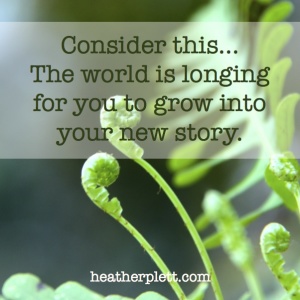 There are many thought leaders who believe that our world is in that empty place – the place of chaos – between Story A and Story B.
There are many thought leaders who believe that our world is in that empty place – the place of chaos – between Story A and Story B.
Yesterday, I participated in the first session of ULab, hosted by Otto Scharmer of MIT and Presencing Institute. On this MOOC (massive open online course) there are 25,000 people who are connecting to talk about the transformation of business, society, and self. We’re learning what it means to be in that “place of disruption” between stories. While on the webinar, thousands of us were tweeting from all over the world about what is ending and what is emerging. There’s a general consensus that the world can’t continue to function unless we step into a new story, a new way of connecting with ourselves, each other, and the world. But before getting to that new story, we have to let ourselves be lost for awhile.
In The More Beautiful World Our Hearts Know Is Possible, Charles Eisenstein talks about The Story of Separation that the world has been living in. That’s a story that keeps us locked in a financial economy that demands growth and the pillaging of the earth for the resources that feed that growth. It’s a story that has us living as separate, self-sufficient individuals instead of in community. It’s a story that requires a greater and greater investment in military actions that help us protect our resources and our self-sufficiency.
The new story that the world is longing for is a Story of Connection.
It’s a story that brings us back to a healthy relationship with each other and the earth. It’s a story of trust and compassion, community and spirituality.
As the diagram above shows, we won’t get to the Story of Connection until we are ready to release the Story of Separation, step into the centre of the labyrinth, and receive the new thing that wants to be born in each of us.
If you find yourself in that empty place between stories, know this – you are not alone. You are living a story that is playing itself out all over the world.
We are all trying to find our way into the new story. Some of us are desperately hanging onto the old story, some of us are ready to hospice the old story into its death, and some of us are ready to midwife the new story into its birth.
In the transformation from caterpillar to butterfly, there are a few cells, called imaginal cells, that hold the dream of the butterfly alive while all of the other cells see only the end of the world that was once their caterpillar life. Those imaginal cells lead the transformation into the new, more beautiful thing that is meant to emerge.
In my work, I am blessed to be in connection with many imaginal cells – people who sense the end of Story A has come and who believe that there is something new and better emerging. Perhaps you are one such cell.
Perhaps you have been invited into the difficult stage of transformation so that you can serve as a model for others coming after you.
I invite you to consider that whatever you are going through right now, you are going through something that is helping you emerge into the more beautiful world. And your transformation is part of the transformation of the world around you.
Step into the labyrinth. Let yourself be changed.
Need some support on this journey through transformation? Registration is now open for The Spiral Path: A Woman’s Journey to Herself. In this 21 lesson course, you’ll be guided through the three stages of the labyrinth journey.
by Heather Plett | Jan 13, 2015 | Community, growth, journey, Leadership
There are many reasons to be silent.
Violence (or the threat of violence) is one reason for silence. When cartoonists are murdered for satire and young school girls are kidnapped or murdered for daring to go to school, the risk of speaking up becomes too great for many people.
Sometimes the violence backfires and the voices become stronger – as in the case of Charlie Hebdo, now publishing three million copies when their normal print run was 60,000. Why? Because those with power and influence stepped in to show support for those whose voices were temporarily silenced. If the world had ignored that violence and millions of people – including many world leaders – hadn’t marched in the streets, would there have been the same outcome? If these twelve dead worked for a small publication in Somalia or Myanmar would we have paid as much attention? I doubt it.
Far too many times (especially when the world mostly ignores their plight, as in Nigeria) violence succeeds and fewer people speak up, fewer people are educated, and the perpetrators of the violence have control.
Violence has long been a tool for the silencing of the dissenting voice. Slaves were tortured or murdered for daring to speak up against their owners. Women were burned at the stake for daring to challenge the dominant culture. Even my own ancestors – the Mennonites – were tortured and murdered for their faith and pacifism.
Most likely every single one of us could look back through our lineage and find at least one period in time when our ancestors were subjected to violence. Some of us still live with that reality day to day.
There is no question that the fear of violence is a powerful force for keeping people silent. It still happens in families where there is abuse and in countries where they flog bloggers for speaking out.
Few of the people who read this article will be subjected to flogging or torture for what we say or write online, and yet… there are many of us who remain silent even when we feel strongly that we should speak out.
Why? Why do we remain silent when we see injustice in our workplaces? Why do we turn the other way when we see someone being bullied? Why do we hesitate to speak when we know there’s a better way to do things?
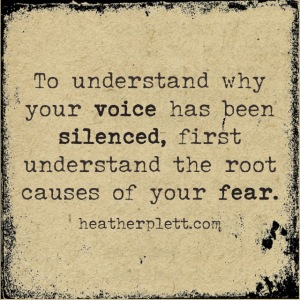 Because we have a memory of violence in our bones. The more I learn about trauma the more I realize that it affects us in much more subtle and insidious ways than we understand. Some of us have experienced trauma and are easily triggered, but even if we never experienced trauma in our own lifetimes, it can be passed down to us through our DNA. Your ancestors’ trauma may still be causing fear in your own life. Witnessing the trauma of other people subjected to violence may be triggering ancient fear in all of us, causing us to remain silent.
Because we have a memory of violence in our bones. The more I learn about trauma the more I realize that it affects us in much more subtle and insidious ways than we understand. Some of us have experienced trauma and are easily triggered, but even if we never experienced trauma in our own lifetimes, it can be passed down to us through our DNA. Your ancestors’ trauma may still be causing fear in your own life. Witnessing the trauma of other people subjected to violence may be triggering ancient fear in all of us, causing us to remain silent.- Because our brains don’t understand fear. The most ancient part of our brains – the “reptilian brain”, which hasn’t evolved since we were living in caves and discovering fire – is adapted for fight or flight. That part of our brain sees all threats as predators, and so it triggers our instinct to survive. Our lives are much different from our ancestors, and yet there’s a part of our brains that still seeks to protect us from woolly mammoths and sabre-toothed tigers. When our fear of being rejected by a family member for speaking out feels the same as the fear of a sabre-toothed tiger, our reaction is often much stronger than it needs to be.
- Because those who want to keep us silent have learned more subtle ways to do so. In most of the countries where we live, it is no longer acceptable to flog bloggers, but that doesn’t mean we’re not being silenced. Women have been silenced, for example, by being taught that their ideas are silly and irrelevant. Marginalized people have been silenced by being given less access to education. Those with unconventional ideas have been “gaslighted” – gradually convinced that they are crazy for what they believe.
- Because we have created an “every man for himself” culture where those who speak out are often not supported for their courage. We’re all trying to thrive in this competitive environment, and so we feel threatened by other people’s success or courage. When I asked on Facebook what keeps people silent, one of the responses (from a blogger) was about the kinds of haters that show up even in what should be supportive environments. In motherhood forums, for example, people get so caught in internal battles (like whether it is better to be a working-away-from-home parent or a stay-at-home parent) that they forget that they would be much stronger in advocating for positive change in the world if they found a way to work together and support each other. It is much more difficult to speak out when we know we’ll be standing alone.
- Because we don’t understand power and privilege. Those who have access to both power and privilege are often surprised when others remain silent. “Why wouldn’t they just speak up?” they say, as though that were the simplest thing in the world to do. It may be a simple thing, if you have never been oppressed or silenced, but if you’ve been taught that your voice has no value because you are “a woman, an Indian, a person of colour, a lesbian, a Muslim, etc.”, then the courage it takes to speak is exponentially greater. Years and years of conditioning that convinces a person of their inherent lack of value cannot be easily undone.
 Several years ago, I visited a village in the poorest part of India. Though I’d traveled in several poor regions in Bangladesh, India, and a few African countries before that, this was the most depressing place I’d ever visited. This was a makeshift village populated by the Musahar people who lived at the edges of fields where they sometimes were hired by the landowners as day labourers but otherwise had to scrounge for their food (sometimes stealing grain from rats – which was why they’d come to be known as “rat eaters”).
Several years ago, I visited a village in the poorest part of India. Though I’d traveled in several poor regions in Bangladesh, India, and a few African countries before that, this was the most depressing place I’d ever visited. This was a makeshift village populated by the Musahar people who lived at the edges of fields where they sometimes were hired by the landowners as day labourers but otherwise had to scrounge for their food (sometimes stealing grain from rats – which was why they’d come to be known as “rat eaters”).
There was a look of deadness in the eyes of the people there – a hopelessness and sense of fatalism. Our local hosts told us that these were the most marginalized people in the whole country. They were the lowest tribe of the lowest caste and so everyone in the village had been raised to believe that they had no more value than the rats that ran through their village.
There was a school not far from the village, but we could find only one boy who attended that school. Though everyone had access to the school, none of the parents were convinced their children were worthy of it.
It was a powerful lesson in what oppression and marginalization can do to people. In other equally poor villages (in Ethiopia, for example) I’d still noticed a sense of pride in the people. The Musahar people showed no sense of pride or self-worth. Essentially, they had been “gaslighted” to believe they were worthless and could ask for no more than what they had.
The next day, my traveling companions and I took a rest day instead of visiting another village. We had enough footage for the documentary we were working on and we needed a break from what was an emotionally exhausting trip.
My colleague, however, opted to visit the second village. He came back to the hotel with a fascinating story. In the second village, a local NGO had been working with the people to educate them about their rights as citizens of India. It hadn’t taken long and these people had a very different outlook on their lives and their values. They were beginning to rally, challenging their local government representatives to give them access to the welfare programs that should have been everyone’s rights (but that people in the first village had never been told about by the corrupt politicians who took what should have been given to the villagers). On the way back to the hotel, in fact, he’d been stopped by a demonstration where the body of a man who’d died of starvation had been laid out on the street to block traffic and call attention to the plight of the Musahar people.
The people in the second village were slowly beginning to understand that they were human and had a right to dignity and survival.
In the coaching and personal growth world that I now find myself in, there is much said about “finding our voices”, “stepping into our power”, and “claiming our sovereignty”. Those are all important ideas, and I speak of them in my work, but I believe that there is work that we need to do before any of those things are possible. Like the Musahar people, those who have been silenced need to be taught of their own value and their own capacity for change before they can be expected to impact positive change.
First we need to take a close look at the root causes of the fear that keeps us silent before we’ll be able to change the future.
When we begin to understand power and privilege, when we find practices that help us heal our ancient trauma, when we retrain our brains so that they don’t revert to their most primal conditioning, and when we find supportive communities that will encourage us in our attempts at courage, then we are ready to step into our power and speak with our strongest voices.
Like the Musahar, we need to work on understanding our own value and then we need to work together to have our voices heard.
These are some of the thoughts on my mind as I consider offering another coaching circle based on Pathfinder and/or Lead with Your Wild Heart. If you are interested in joining such a circle, please contact me.
Also, if you are longing to understand your own fear so that you can step forward with courage, consider joining me and Desiree Adaway at Engage!
by Heather Plett | Jan 5, 2015 | circle, women
 Sanctuary.
Sanctuary.
A sacred place. A place of refuge. A place where wild beings are safe in their natural habitat.
That’s what I want to focus on this year. Sanctuary. For myself and for others.
The word came to me while I was working on the prompts for A Soulful Year. One of the prompts is an invitation (in mandala form) to consider what you are most longing for in the coming year. Half way through my intuitive writing on longing, I knew what I want most and what I most want to create for others.
I want sanctuary.
First, there’s the practical, bricks and mortar kind of sanctuary. I want a space where I can work, create, write, and host conversations. I want a place of refuge and quiet, where my work can blossom, and my wild heart can thrive in its natural habitat. I don’t know what that will look like yet, but it is becoming more and more imperative that I move my business out of our house (which is relatively small for a family of five and has very little dedicated space for my work). It may look like a whole new house for our family that includes a space that can be used as studio/classroom. Or it may look like a rented studio/classroom. I’m open to the right solution and the right space.
And then there is the kind of sanctuary that I want to create. For you, my dear clients, friends and readers.
In all that I do – my writing, workshops, classes, etc. – I want to create safe, sacred space. I want to create the kind of space, both with my words and with my physical presence, where it feels like you’ve come home, to safety, to belonging, and to your own wildness.
Because we are ALL longing for this. We are ALL in need of sanctuary.
We need places where our hearts can crack open without fear of judgement.
We need places where our tears can flow without hindrance.
We need places where we know we will be held.
We need sanctuary. We need refuge. We need the sacred.
Last year, while visiting Oakland, California, I wandered along the edge of a lake and then stopped to visit a beautiful church perched at the edge of the lake. I was struck by the fact that both of those places were considered “sanctuaries”. One was a bird sanctuary, where birds were safe from hunters and predators, and one was a religious sanctuary, where the weak and weary could find spiritual solace.
I want the best of both kinds of sanctuary.
I want a spiritual sanctuary, where questions are welcome, where the hungry are nourished, and where nobody is judged for whatever spiritual path their on. AND I want a wildlife sanctuary, where the wild in all of us can run free and unhindered; where we can soar through the sky, or float across the water; where we can build our nests and tend to our young without fear.
In 2015, I will seek and create sanctuary in my work, in my community, in my family, and in myself.
I will make it a priority to find the right space that will nourish me, my family, and my work.
I will make it a priority to create sanctuary for my clients, whether they come to me for coaching, attend my retreats or workshops, sit in circle with me, or participate in my online offerings. I will welcome their vulnerability and cheer on their wildness.
I will make it a priority to create sanctuary on this blog, offering you, my readers, a safe place where you can come when you are hungry for stories that leave you feeling less alone.
I will make it a priority to serve in my community, helping wherever I can to offer sanctuary to those who need it.
Tell me… what kind of sanctuary are you seeking? And how can I help you find it? I would love to hear in the comments.
Note: I’m beginning the year by creating sanctuary for women in Winnipeg. I’ll be hosting an inaugural Women’s Circle (that will hopefully become a regular gathering) on Thursday, January 15th at 7:00 p.m. It’s free and all are welcome. Find out more here.
 “Release, receive, and return.” That’s what the labyrinth invites us to do.
“Release, receive, and return.” That’s what the labyrinth invites us to do.









 Several years ago, I visited a village in the poorest part of India. Though I’d traveled in several poor regions in Bangladesh, India, and a few African countries before that, this was the most depressing place I’d ever visited. This was a makeshift village populated by the
Several years ago, I visited a village in the poorest part of India. Though I’d traveled in several poor regions in Bangladesh, India, and a few African countries before that, this was the most depressing place I’d ever visited. This was a makeshift village populated by the 